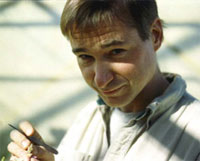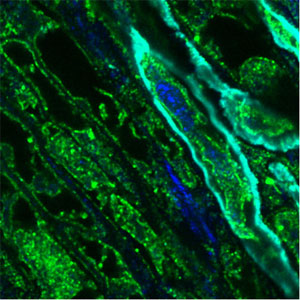Columbia, Missouri
February 16, 2006
Source:
National Science Foundation
New data
suggest that molecular communication between the plant
sexes--specifically the pollen of males and pistils of
females--is more complicated than originally thought. Plants,
like animals, avoid inbreeding to maximize genetic diversity and
the associated chances for survival. For decades, scientists
have sought to fully understand the plant's molecular system for
recognizing and rejecting "self" so that inbreeding does not
occur.
|
 |
|
In flowering plants, reproduction is initiated when the
pollen (the male) reaches the pistil (the female). For
successful fertilization, the pollen must germinate and
form a tube that grows within the pistil in order to
reach the ovule. As the pollen tube extends, molecular
information is exchanged that determines the
compatibility of the pollen and pistil, such as their
degree of genetic relatedness. In some plants, a toxin
called S-RNase poisons the pollen tube if the pollen and
pistil are too closely related, thus preventing
inbreeding. Recent studies by Bruce McClure suggest the
toxin is sequestered until the compatibility decision is
made.
Credit: Nicolle Rager Fuller,
National Science Foundation |
Now, Bruce
McClure at the University of Missouri-Columbia (UMC), together
with his colleagues, report in the Feb. 16 issue of the journal
Nature that
plant "self" recognition systems involve multiple players and
lots of male-female "conversation," at least at the molecular
level.
For
successful reproductions to occur in plants, the pollen must
make its way to the plant's female parts. That is, it germinates
and grows within the pistil in order to reach the ovule. In one
system plants use to prevent inbreeding, the pistil literally
poisons the pollen en route to the ovule using a toxin known as
S-RNase. Until now, the specifics of this self-incompatibility
system perplexed scientists.
McClure and
his colleagues showed that after the pistil injects S-RNase into
the pollen, the toxin is whisked away to a holding compartment
where it can do no harm until the "self" or "non-self" decision
is made. McClure's work also suggests that at least three other
proteins may be involved in this decision-making process.
McClure
said, "What's really new here is the finding that pollen
protects itself from the toxin in a different way than we
previously thought, and we're starting to understand how these
other proteins work together with S-RNase." McClure's group is
now determining the molecular information responsible for the
sequestering and release of S-RNase.
McClure
also engages UMC freshman biochemistry laboratories in studying
this plant self-recognition system to learn and perform advanced
molecular biology. "It's a great system for helping students see
how we connect genetics and biochemistry and use them to build
an understanding of how living things work," said McClure.
McClure
first showed that RNases were involved in controlling plant
mating some 17 years ago. In 1994, he and Teh-hui Kao at
Pennsylvania
State University, both supported by the National Science
Foundation (NSF), independently determined the toxin's function.
Recently, Kao's lab made another key advance by showing that a
pollen protein called SLF helps pollen recognize S-RNase.
Susan
Lolle, the NSF program manager for McClure's current research
said, "This latest development in the pollen-pistil story is not
only significant in its own right as we strive to understand the
intricacies of plant breeding--it's also a great example of how
stepwise advances in fundamental knowledge lead to our greater
understanding of a complex system."
Missouri
University investigators' discovery sheds light on how plants
control mating
Source:
University of
Missouri-Columbia
By: Melody Kroll
Like
animals, most plants avoid mating with close relatives. But, how
plants decide who is a relative has been a mystery to science.
New research from
Missouri University investigators suggests that this
decision-making process is more intricate than previously
considered.
|
 |
|
Dr. Bruce McClure
pollinates a Nicotiana alata plant in the greenhouse. |
In plants,
some of the important mating choices are made through an
intimate "conversation" between the pollen (the male) and the
pistil (the female part of a flower). The conversation is
carried on with molecules instead of words. One molecular-level
conversation scientists have been eavesdropping on for a long
time is the one a plant may have with itself to avoid
self-mating, or inbreeding. How this conversation occurs is now
turning out to be quite complex.
"We've
known that there is a molecular conversation going on between
S-RNase, a protein on the pistil side, and SLF, a protein on the
pollen side, and that the result of this conversation is a
decision about whether or not the pollen will be allowed to
fertilize the plant.in other words, who to mate with and who to
reject," said
Bruce McClure, Associate Director of the Christopher S. Bond
Life Sciences Center and the lead investigator for the research.
"We used to think these two proteins interacted pretty
directly."
In this
week's Nature, McClure and fellow MU investigators show
that S-RNase is taken up into a compartment inside a growing
pollen tube.
"That
S-RNase is sequestered in a compartment — away from the SLF
protein — really changes how we think about this interaction,"
continued McClure. "It means the conversation is a lot more
intricate and two-sided than we had thought."
McClure,
who received funding for the research from both the National
Science Foundation and the MU-Monsanto Plant Biology Program,
said the finding is important for a basic understanding of plant
biology, but may also offer insight into other issues, like the
spread of transgenes from genetically modified crops to wild
relatives.
|
 |
|
Pollen tubes (white)
growing in a pistil. S-RNase (blue) and 120K (green) are
secreted by pistil cells and taken up by the pollen
tube. S-RNase and 120K end up in a pollen tube vacuole
and the image shows how 120K surrounds the S-RNase. The
pollinated pistil was fixed and stained with antibodies.
The image was obtained with a confocal microscope and
represents a single 300nm thick optical section and is
about 70 um square. Credit: Ariel Goldraij, Mayandi
Sivaguru, and Bruce McClure, University of
Missouri-Columbia |
In studies
in 1989 and 1990 (also in Nature), McClure showed that
S-RNase causes rejection of pollen from close relatives by
acting as a cytotoxin (toxic substance) inside the cytoplasm of
the growing pollen tube. What scientists know now is that pollen
keeps S-RNase safely stored in a bag-like compartment where it
cannot cause damage unless it is released. The molecular
conversation between S-RNase and SLF controls this release. With
this new finding, scientists now envision the pollen-pistil
conversation as involving a whole new set of interactions.
"It's as
much where the molecules are as what they are," McClure said.
"We used to think that the important molecular decision made
between mating partners was whether or not to degrade S-RNase.
We now know the important decision is whether or not to release
the S-RNase from this compartment. This takes us in a whole new
direction of research."
For their
studies, the MU team used Nicotiana alata, a relative of
tobacco commonly grown in home gardens as "flowering tobacco."
The advanced microscope facilities in the Molecular Cytology
Core at the Bond Life Sciences Center were critical for
discovering the S-RNase compartment.
"The
combination of a great team and great facilities made this
possible," said McClure. "We had team members from Argentina,
Japan, India, Mexico, and the United States. It's an incredible
collaborative effort."
Among the
team members are an MU graduate student in the Division of
Biological Sciences, Christopher Lee, and three MU
investigators, Katsuhiko Kondo, Mayandi Sivaguru, and Thomas E.
Phillips. Nathan Hancock, an MU alumnus, also participated in
the research, as did Ariel Goldraij, from the National
University of Cordoba, Argentina, and Sonia Vasquez-Santana and
Felipe Cruz-Garcia, from the National University of Mexico.
|